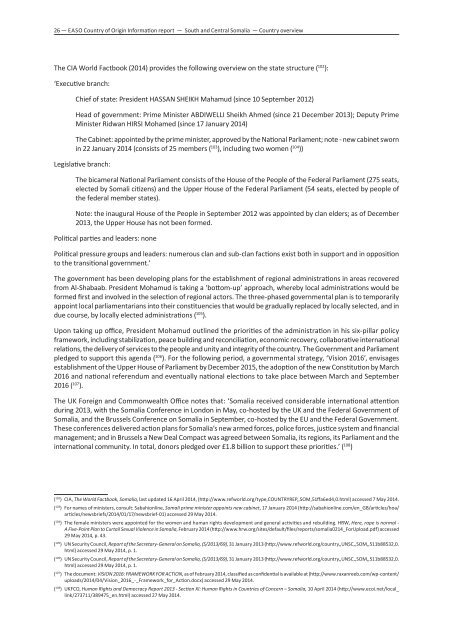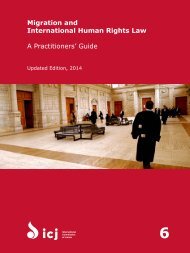You also want an ePaper? Increase the reach of your titles
YUMPU automatically turns print PDFs into web optimized ePapers that Google loves.
26 — EASO Country of Origin Information report — South and Central <strong>Somalia</strong> — Country overview<br />
The CIA World Factbook (2014) provides the following overview on the state structure ( 102 ):<br />
‘Executive branch:<br />
Chief of state: President HASSAN SHEIKH Mahamud (since 10 September 2012)<br />
Head of government: Prime Minister ABDIWELLI Sheikh Ahmed (since 21 December 2013); Deputy Prime<br />
Minister Ridwan HIRSI Mohamed (since 17 January 2014)<br />
The Cabinet: appointed by the prime minister, approved by the National Parliament; note - new cabinet sworn<br />
in 22 January 2014 (consists of 25 members ( 103 ), including two women ( 104 ))<br />
Legislative branch:<br />
The bicameral National Parliament consists of the House of the People of the Federal Parliament (275 seats,<br />
elected by Somali citizens) and the Upper House of the Federal Parliament (54 seats, elected by people of<br />
the federal member states).<br />
Note: the inaugural House of the People in September 2012 was appointed by clan elders; as of December<br />
2013, the Upper House has not been formed.<br />
Political parties and leaders: none<br />
Political pressure groups and leaders: numerous clan and sub‐clan factions exist both in support and in opposition<br />
to the transitional government.’<br />
The government has been developing plans for the establishment of regional administrations in areas recovered<br />
from Al‐Shabaab. President Mohamud is taking a ‘bottom‐up’ approach, whereby local administrations would be<br />
formed first and involved in the selection of regional actors. The three‐phased governmental plan is to temporarily<br />
appoint local parliamentarians into their constituencies that would be gradually replaced by locally selected, and in<br />
due course, by locally elected administrations ( 105 ).<br />
Upon taking up office, President Mohamud outlined the priorities of the administration in his six‐pillar policy<br />
framework, including stabilization, peace building and reconciliation, economic recovery, collaborative international<br />
relations, the delivery of services to the people and unity and integrity of the country. The Government and Parliament<br />
pledged to support this agenda ( 106 ). For the following period, a governmental strategy, ‘Vision 2016’, envisages<br />
establishment of the Upper House of Parliament by December 2015, the adoption of the new Constitution by March<br />
2016 and national referendum and eventually national elections to take place between March and September<br />
2016 ( 107 ).<br />
The UK Foreign and Commonwealth Office notes that: ‘<strong>Somalia</strong> received considerable international attention<br />
during 2013, with the <strong>Somalia</strong> Conference in London in May, co‐hosted by the UK and the Federal Government of<br />
<strong>Somalia</strong>, and the Brussels Conference on <strong>Somalia</strong> in September, co‐hosted by the EU and the Federal Government.<br />
These conferences delivered action plans for <strong>Somalia</strong>’s new armed forces, police forces, justice system and financial<br />
management; and in Brussels a New Deal Compact was agreed between <strong>Somalia</strong>, its regions, its Parliament and the<br />
international community. In total, donors pledged over £1.8 billion to support these priorities.’ ( 108 )<br />
( 102 ) CIA, The World Factbook, <strong>Somalia</strong>, last updated 16 April 2014, (http://www.refworld.org/type,COUNTRYREP,,SOM,51ffa6ed4,0.html) accessed 7 May 2014.<br />
( 103 ) For names of ministers, consult: Sabahionline, Somali prime minister appoints new cabinet, 17 January 2014 (http://sabahionline.com/en_GB/articles/hoa/<br />
articles/newsbriefs/2014/01/17/newsbrief-01) accessed 29 May 2014.<br />
( 104 ) The female ministers were appointed for the women and human rights development and general activities and rebuilding. HRW, Here, rape is normal -<br />
A Five‐Point Plan to Curtail Sexual Violence in <strong>Somalia</strong>, February 2014 (http://www.hrw.org/sites/default/files/reports/somalia0214_ForUpload.pdf) accessed<br />
29 May 2014, p. 43.<br />
( 105 ) UN Security Council, <strong>Report</strong> of the Secretary‐General on <strong>Somalia</strong>, (S/2013/69), 31 January 2013 (http://www.refworld.org/country,,UNSC,,SOM,,511b88532,0.<br />
html) accessed 29 May 2014, p. 1.<br />
( 106 ) UN Security Council, <strong>Report</strong> of the Secretary‐General on <strong>Somalia</strong>, (S/2013/69), 31 January 2013 (http://www.refworld.org/country,,UNSC,,SOM,,511b88532,0.<br />
html) accessed 29 May 2014, p. 1.<br />
( 107 ) The document: VISION 2016: FRAMEWORK FOR ACTION, as of February 2014, classified as confidential is available at (http://www.raxanreeb.com/wp‐content/<br />
uploads/2014/04/Vision_2016_-_Framework_for_Action.docx) accessed 29 May 2014.<br />
( 108 ) UKFCO, Human Rights and Democracy <strong>Report</strong> 2013 - Section XI: Human Rights in Countries of Concern – <strong>Somalia</strong>, 10 April 2014 (http://www.ecoi.net/local_<br />
link/273711/389475_en.html) accessed 27 May 2014.



